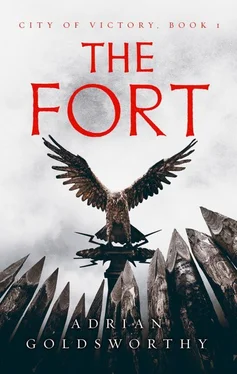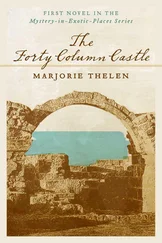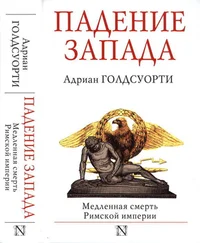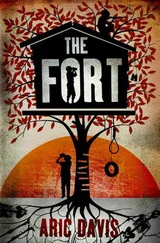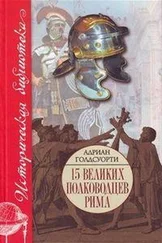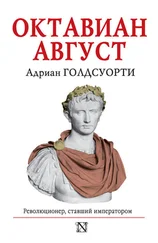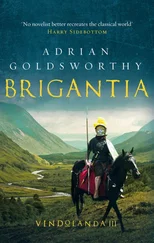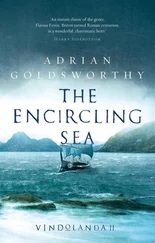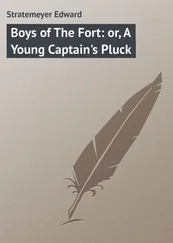This is even more true of the fascinating monuments at Tropaeum Traiani (modern Adamklissi in Romania, not far from the Black Sea). Dedicated to Mars Ultor – Rome’s war god Mars in his role as the avenger – these include an altar and a cenotaph, a memorial to the ‘bravest of men’ who fell, presumably during one of the conflicts with the Dacians and their allies. (Among the units listed is one from Britannia, which might well make this the first extant memorial to British soldiers.) On the great drum-shaped Tropaeum itself, there were sculptures of captives, and a row of scenes or metopes depicting battle scenes, where Roman legionaries and auxiliary infantry and cavalry parade and fight against barbarians until these are killed or captured. There is a story in these images, but we do not know what it is, in part because we do not even know the original sequence of the metopes, let alone the precise date of the incidents depicted.
The cenotaph has the space for some 3,800 names, but is badly eroded so that most of it is illegible. The first man listed was a praefectus or prefect, and while his name is lost, it states that he was born in Pompeii, but now resident in Neapolis (Naples), which means that he died sometime after the eruption of Vesuvius. Some scholars believe that the names are those of men who fell in a great disaster, perhaps one of the two major defeats suffered under Domitian. So many fatalities make it highly unlikely that the monument commemorated a hard-fought victory, but that leaves the possibility that it includes the names of all the men who had died during the course of one or both of the Dacian Wars. As with so much concerning the period, we simply do not know. The sculptures give a better idea of the true appearance of the peoples of the region and also what Roman troops looked like in the field.
The Fort makes use of the little certain information we do possess. Trajan’s First Dacian War imposed a treaty on Decebalus, including a ban on hiring Roman deserters and on seeking allies. It also resulted in the establishment of Roman garrisons within his kingdom, mainly in the lowlands and the valleys leading to and from passes in the Carpathians. There was a Roman detachment at Decebalus’ capital of Sarmizegethusa Regia and part of its substantial defensive wall has been excavated, although the details of the post are not very well understood.
The peace proved temporary and there is a fair chance that both sides prepared for hostilities long before they resumed. One of the most visible signs of this was the great bridge across the Danube, which was opened by the end of AD 105 and part of a wider programme improving communications in the area. The base of only one pier remains to this day, but confirms the scale of the project, which was described in some detail by Dio and is depicted on Trajan’s Column. Trajan left Rome for the Danube on 4 June AD 105, so that much of the campaigning season was already spent before he arrived in the theatre of operations, and it looks as if he was taken by surprise. Trajan’s Column also shows a number of Roman forts under Dacian attack before the emperor arrives, while Dio told the story of the capture of Longinus. Rather than be used as a pawn in negotiations, the Roman officer committed suicide, using poison obtained by a freedman. The narrative does not make clear whose freedman this was, but claims that Decebalus demanded his return after the man escaped, offering his remaining Roman hostages as payment. Trajan refused.
The Fort takes these fragments and depicts an uneasy peace with men on both sides anticipating a renewal of war and trying to gain an advantage. Sosius in our story is fictional, for we know nothing about this freedman, nor does the summary of Dio hint at foul play behind the scenes of Longinus’ death. As stated at the start of the book, there was a Roman fort at a place called Piroboridava occupied at this time, but it was not located where it is in the story. Our Piroboridava is fictional, loosely based on the remnants of early phases of forts, such as the site at Rãcari in Romania. Counter attacks or large scale raids were a feature of Dacian war-making, partly for plunder and prestige, but also to wrong-foot the enemy. The heartland of Decebalus’ kingdom lay high in the mountains, which meant that it was virtually impossible to attack it on a large scale during the winter months. Thus delaying any Roman campaign was well worthwhile. When Hadrian became emperor, he had the Danube Bridge decommissioned, removing the road and leaving just the pillars and arches, which still looked impressive four centuries later. The Romans were not usually fond of bridges on their river frontiers, and some, like Hadrian, appear to have seen them as vulnerable spots. Trajan’s construction of the bridge was a sign of confidence, even bravado, which his successor did not share. Our story offers a reason for Hadrian’s fears and subsequent action.
The Roman army is depicted as accurately as possible in the story, just as in the Vindolanda trilogy, but there is much that is guesswork and more detail can be found on my website and in books such as my The Complete Roman Army . Epigraphic evidence as well as logic suggest that a legion would have had an unusually high proportion of veterani some twenty years after its initial formation, although it is far less clear what was done with these men for the last period of their military service. In later centuries the frumentarii expanded their duties far beyond the organisation of supplies and became a form of secret police, bringing information to the emperor about the activities of his officers in the provinces. Hadrian is credited with starting this process, so there seemed no harm in suggesting that the idea had already occurred to him long before he became emperor.
Ferox is fictional, as is the irregular unit of Brigantes placed under his command. Such tribal units were increasingly common in the early second century AD; Trajan’s Column depicts bare-chested barbarians wielding clubs fighting alongside regular auxiliaries as well as legionaries. In later years the vague term of numerus or unit was often associated with these regiments, but at the time of our story they were usually referred to by an ethnic designation and listed as ‘under the care of’ ( sub cura ) a named commander. Little is known of their internal organisation and equipment, and there is a good chance that such units varied considerably, being composed and organised to meet a local need or simply on the basis of available manpower.
Ferox will be familiar to readers of my Vindolanda trilogy, as will Vindex, Enica, Philo and co, and the story of the Brigantian rebellion. Sadly all are fictional, as are the majority of the men at the fort and elsewhere. Sulpicia Lepidina and her husband Cerialis were real, attested in the Vindolanda writing tablets, although their stories have been considerably fleshed out in my novels. No trace of their lives has survived for the years before they came to Vindolanda and after they left. A Lucius Tettius Crescens is recorded on an inscription from Sardinia, noting that he was merchant in Dacia at the time of the war. A centurion and Roman citizen named Petrullus is recorded a generation later as having come from Britannia, so our Petrullus is meant to be his father whose loyal service gained the family the franchise.
Maximus – fully Tiberius Claudius Maximus – is known from his tombstone, which records his career as a legionary cavalryman, who subsequently rose to become a decurion of auxiliary cavalry, serving as standard-bearer, a member of the acting governor’s bodyguard and scout along the way. He led the party that chased down Decebalus at the end of the Second Dacian War, and is depicted on his own monument and on Trajan’s Column riding forward just as the king slits his own throat. Highly decorated, Maximus’ career appears less distinguished than might be expected, which may suggest that he was one of those soldiers very good at fighting, but perhaps less suited to peacetime routine.
Читать дальше
